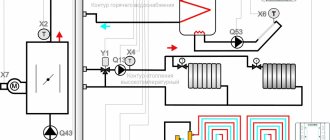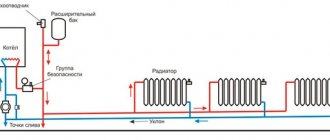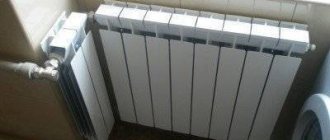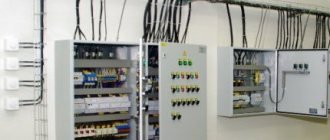How smart heating works
The heating system of an apartment or country house includes not only radiators, but also various types of convectors, heated floors, and heated towel rails. Recently, the option of warm walls that heat the air in the room in winter and cool it in summer has become popular.
This entire set, and in a country house, devices responsible in one way or another for heating, can be controlled separately or in combination.
The control system can be a single computer unit that controls appliances in the house and temperature sensors in rooms and outside.
The system analyzes the sensor readings, and if the temperature differs from that set in the program, it gives a command to work. The temperature regime comfortable for staying in the house is set individually by the owner.
Smart heating can be economical, but subject to a number of conditions. So, the temperature in the house is affected not only by the weather outside the window, but also by other factors that influence the climate in the house, namely:
- thermal conductivity of walls and ceilings;
- quality of windows installed in the house;
- quality and sufficient protection of the front door;
- heat supply method;
- type of heating system in the house;
- the presence of dampness, drafts, and so on.
And even the smartest system will not work with proper efficiency if the causes leading to heat loss are not eliminated to the maximum. If the walls are not sufficiently protected, the system will heat the air, and you will lose the money spent on its operation.
Of course, in this case, the comfortable temperature you set will be maintained, but it will require more energy to complete the task.
How is smart heating controlled?
It all depends on whether you buy a ready-made system, or try to implement it yourself.
It is possible to create a smart heating system in your home yourself, but it involves a lot of nuances. Controllers can be installed on each device and heating unit, which will be connected to temperature sensors in the house.
Next, you set the required temperature and the option when the device stops working: upon reaching a certain air temperature, or at the time of switching on and off.
Implementing the system in this way has a number of significant drawbacks: the devices installed in the house are configured separately and are not connected to each other, that is, they will not be able to “agree” on their work. Moreover, the devices installed in the house will not respond to cold weather outside the window, since they will not receive information about it.
Centralized control of smart heating is also possible. Devices are controlled remotely using a single system, with each group of devices given its own settings.
Such a system works as a complex and does not require individual configuration of each individual device. Due to the fact that all devices in the system communicate information to each other, they are able to work together, which makes it possible to solve the task of achieving a comfortable temperature more efficiently and economically.
Again, purchasing a ready-made smart heating package with a particular task is much easier than doing it yourself.
In order for the heating process to be more efficient, a rational solution would be to distribute the area of the house into specific temperature zones and set the operating program for the appliances for them.
Let's say the living area will receive heat more actively, the garage, corridor or vestibule will be heated with less intensity. This is another way to reduce system operating costs.
An important condition for the effective operation of the system is the presence of temperature sensors not only inside the house, but also outside it. Due to the fact that the heating system can correlate the temperature inside and outside, it can set the optimal operating rate independently, without intervention from the owner.
Climate and heating control in a smart home
Our health and performance depend on microclimate conditions, freshness and cleanliness of indoor air. The “smart home” system allows you to control a modern home rich in heating and ventilation systems, lighting and electrical equipment and takes care of the health and comfort of its inhabitants.
Climate control in a smart home system is achieved by integrating three climate systems - heating, ventilation and air conditioning, when these engineering systems function as a single whole, providing comfortable climate control modes in the premises. Its implementation begins at the design stage of climate control systems, when operating algorithms are set that allow maintaining the required indoor air parameters (temperature, humidity and chemical composition) with minimal energy consumption. Climate control is an indispensable attribute of a modern “smart home”.
The operation of the system is ensured by supply ventilation, air conditioners, humidifiers and dehumidifiers, ionizers, electric or water heating, heated floors (electric and water), and window opening drives. For control, sensors are used that record the current state of the microclimate in the house, as well as control means - switches and panels. The “smart home” system allows you to remotely control the climate via the Internet, cell phone, or from the dispatcher’s computer.
Climate systems are designed with the ability to analyze temperature and humidity using special sensors in those rooms where it is necessary to maintain specified climatic parameters. The smart home control system, using the climate control algorithms embedded in it, sends control signals to the servos of appliances and heating circuits or air valves of the ventilation system with a cooling system.
Flexible adjustment of the thermal control system not only improves home comfort, but also saves energy costs. By monitoring the temperature inside and outside the room, the “smart home” automatically creates favorable conditions for its inhabitants. With properly configured control, devices behave differently with open and closed windows, in the presence or absence of people in the room, at different times of day and days of the week, etc.
The system allows you to control parameters such as temperature, humidity, fresh air flow individually for each room, turn on/off the air filtration system, create an individual climate system for each family member, and save money, solving the problem of energy saving. In particular, the system can be configured so that the heat supply during non-working hours and on weekends is reduced or turned off completely.
The implementation of climate control modes allows us to ensure optimal energy consumption modes for climate control systems. The heating and air conditioning systems in a “smart home” do not work “toward each other” (the heating system does not cool the air that the heating system heats).
Climate control in the premises is carried out using specialized climate controllers and thermostats, as well as using multifunctional climate control systems for a “smart” home.
24-hour control over the smart home system eliminates the occurrence and development of emergency situations. Failure of one of the system nodes will not affect overall safety. In the event of failure of the main controller of the Smart Home system, each engineering system still retains autonomous control functions.
Smart home heating supply with weather-dependent controller and regulator
The now familiar concept of “smart home” should be understood not only as a country house, a house outside the city limits, or a house outside the city. An apartment in the city, an office, and many other types of premises fit perfectly into this awareness. If we consider the heating system from this point of view, then with such an approach to it it is necessary to implement several basic principles. When we say smart home, the heating supply in this case should provide comfortable living conditions or savings on costs for its own maintenance.
Smart House
- What kind of heat supply can there be?
- How is it organized
It has long been known that comfort does not come for free. Any attempt to provide ancillary amenities or to free yourself from unnecessary worries through the use of automation will mean increased costs. However, regardless of our desire, for a smart home, heating plays an almost important role in creating comfortable conditions, and in most cases the costs of its maintenance depend on its organization.
In the case when the equipment used, automation and control means are selected and applied correctly, then the heating system - whether it will heat a smart home, a living space or a garage - does not matter; in addition to maintaining the specified conditions, it will also be able to provide fuel economy.
This can initially be achieved by the mutual action of the heating boiler with the control center. In addition to the presence of personal safety equipment, a boiler of this type has a communication interface, thanks to which it is possible to implement smart heat supply to a country house. In its most primitive form, this must be understood that a smart home controls heat supply depending on the temperature achieved in the room based on signals from sensors.
Elements of a heat supply control system in a smart home
A good option for similar control is temperature control of the coolant. But with all the advantages of such a heat supply system, there are other, much better approaches to organizing heating work. Currently, weather-compensated heating control is considered promising.
How is it organized
With a similar approach, in addition to everything, an external temperature sensor is also used in addition to the home temperature sensor. As a rule, a weather-dependent heat supply regulator will work with one external sensor, but the use of two makes it possible to achieve more accurate mode maintenance and even self-adaptation of the system.
Weather-compensated controller with thermal converter
The weather-dependent heating system controller does not stop operating based on the programmed curve of correspondence between the temperature of the coolant and external conditions. In its most primitive form, it looks like this - if it gets colder outside, then the temperature of the water in the system increases, if it gets warmer, it decreases.
One of the base points for weather control of heat supply can be a temperature of plus twenty degrees - at which the temperature of the coolant is taken equal to that around it, and the heating is practically turned off.
A similar approach to organizing heat supply should also include zonal management, i.e. in individual places the temperature must be additionally adjusted in relation to the specific one using an external sensor. If, for example, a lot of people have gathered in one of the rooms, due to which it has become hotter, then the system detects a local increase in temperature relative to the one set by the atmospheric heat supply regulator and makes a correction in this zone.
The use of two sensors - outdoor and indoor, in addition to saving fuel, reduces the inertia of the system, which increases its effectiveness and will also provide an additional reduction in maintenance costs.
Very often, the most correct choice for organizing heat supply work will be the use of heating technologies characteristic of a smart home. In this case, you can achieve both an increase in the level of comfort in the house and savings on heating costs.
Smart home heating control system.
Let's focus on the heating control section. And so, with the help of smart home heating equipment, we get with you an automated heating control system in the house. Using the smart home heating control system, we can control the temperature in the room manually, we can control the climate in the house remotely using a smartphone or computer, and we can prescribe various scenarios that change by time interval or other actions.
GSM smart home heating control circuit
Usually you can install the system yourself. This requires checking the condition and analyzing the capabilities of existing equipment
It is also important to correctly select the missing components. Typically, a set of control devices is built from a single block, which is the connecting link between all components of the heat supply
It must be installed subject to the following conditions:
- The control unit should be located at a distance of no more than 300 meters from the user. To increase the distance, radio-controlled modifications are purchased, coordination is connected via the Internet or cell phone.
- The use of a controller based on heat supply control boards ensures the installation of additional functions.
- A careful selection of the location in the house for installation of the control unit is carried out.
The main equipment of a smart home is heating.
Smart home heating equipment includes: control controllers, thermostats, temperature sensors, door and window opening sensors, thermal heads and smart sockets, as well as many, many other equipment.
A thermostat is a device, due to a temperature sensor installed in it, that monitors the ambient temperature readings and maintains the necessary microclimate in a house or a separate room.
Sensors - monitor the temperature of air, water or other coolant in real time. Transmits information to control controllers. Serve both for informational purposes and to increase the safety level of heating equipment.
Control controller is the main control device, which receives signals from thermostats, sensors and other devices included in the system. The controller processes the signals and sends the necessary commands to the actuators.
Smart home equipment for apartments, the price depends on the manufacturer and the functionality of the system.
Heating system in a smart home, smart boiler and more
The air temperature in the house depends on the efficient operation of heating devices, the heat output of which must compensate for the thermal losses of the building; the level can vary depending on weather conditions: wind speed, humidity, time of day.
A simple relationship arises: the higher the heat losses (or, the worse the weather), the greater the heat transfer the heating devices must provide and the greater the amount of heat the heating boiler must produce.
You can control the operation of the boiler manually by increasing or decreasing the fuel supply to the combustion chamber. But, you see, it is better if the heating boiler can determine for itself how much heat it needs to generate and how much fuel it needs to burn for this.
Automatic control system - the first step towards a smart boiler
Modern heating boilers in Smart houses are equipped with automatic control systems that can adjust the intensity of fuel combustion depending on the actual need for thermal energy.
However, the response to changes in weather conditions of a conventional boiler may be delayed by several hours, depending on the degree of inertia of the heating system. The fact is that the automatic control system of heating boilers (let’s call them ordinary, as opposed to “smart” heating boilers) is overwhelmingly configured to change the temperature of the water in the return line: the water in the return pipeline cools down more, the fuel supply to the combustion chamber increases, the temperature the return flow is higher, the fuel supply to the combustion chamber decreases.
In turn, the coolant cools down faster, the lower the air temperature in the heated room.
Another important detail: a quick response of the boiler to changes in air temperature is only possible when using heating devices with a small internal volume, for example, aluminum or bimetallic radiators.
Video - Bitherm boiler with a movable grate and a smart control unit
Smart heating boiler
The operation of the smart boiler is controlled using a thermostat with a temperature sensor installed in one of the rooms. The principle of operation is extremely simple: using a thermostat, the desired temperature is set, upon reaching which the boiler turns off. When the temperature drops, the boiler is switched on and the process is repeated again.
By placing the temperature sensor outside, you can set the boiler to operate “advanced”: the outside air temperature has dropped, the boiler operates in a more intensive mode.
The timer in the smart boiler is designed to select intensive and moderate operation modes. So, for example, at night, a slightly lower temperature is more comfortable, about 2-3 degrees compared to the daytime temperature. In this case, at night you can turn off the water heating in the boiler. The mode of moderate operation of the boiler can be programmed during the daytime, when all the inhabitants of the house are at work. The boiler operating modes can be set during the day, during the week, month and even year.
For this purpose, the smart boiler is equipped with a self-diagnosis system.
Boiler self-diagnosis system
The boiler self-diagnosis system allows you to identify from 10 to 40 (depending on the boiler model) faults, a number of which can be eliminated automatically. Information about detected faults is displayed on the display and stored in the device’s memory.
All this makes the operation of smart boilers not only convenient, but also safe, eliminating the possibility of emergency situations, such as a decrease in coolant temperature below a critical level, a decrease in draft, a drop in pressure in the gas pipeline network and a number of other equally dangerous situations that cannot be excluded during boiler operation .
"Smart home" - smart heating
No matter how efficiently the boiler works, to ensure truly comfortable conditions in the house you need controlled heating devices that can respond to changes in room temperature. To do this, radiators are installed in the heating system, equipped with thermostats and servo drives that change the coolant flow depending on the ambient temperature.
Let's sum it up
The heating system of a smart home can be based on a heating boiler equipped with a self-diagnosis system and weather-dependent automation, the operation of which is only effective in conjunction with radiators equipped with thermostats and servos.
umniedoma.ru
Features of organizing a heating system in a smart home
How to assemble a smart home system, connect heating and remote control, as well as other complexes (ventilation, air conditioning, lighting) is a question that should be resolved at the stage of planning the house and the system as a whole. It all depends on the selected control module, its capabilities and the number of relays.
For example, if a module with 12 channels is installed (for example, MP716 Laurent-112), then you can connect up to 12 points for subsequent control, and then the “smart home” plan will be radically different from a system with 6 channels.
Thus, first you need to buy a controller, and then relays, sensors and other components of a “smart home”. This is also due to the fact that different units may have different protocols (Z-Wave is different from ZigBee, and so on), so you need to select not components for the controller, but vice versa.
Recently, Xiaomi has been supplying its own controllers to the market.
After purchasing the control unit, you can plan the heating system. The centralized local controller must have a direct connection to all zone relays (if used) or to each of the heating elements. If only radiators and a boiler are connected to the smart home, they can be controlled using thermostats or other sensors installed at the outlet of the radiators.
How to form a network of devices and relays, you need to understand the layouts individually - but it is important to follow the logic and take into account the peculiarities of the local power grid.
Smart home heating circuit and control systems, photos and videos
A smart building implies a resource-efficient office or retail structure that uses all the used sources of vital amenities in a practical and correct manner. Smart home - heat supply, electrical energy and more, as well as a moderate effect on the external environment.
In other words, this type of building is characterized by the ideal production, storage and management of energy in a domestic project. Today, resource-efficient houses can be not only country houses, houses outside the city or equipped summer cottages, but also traditional apartments.
Type of smart home system
In conditions of sharp temperature rises throughout the year, the issue of heat supply to residential premises is quite important. Most residents complain that during cold weather, heating radiators provide very little heat, and when the heat comes, they heat up to the fullest. What ends up happening is that people overpay for things they don't need. If your heating system is in order, but you are familiar with this not very pleasant phenomenon from hearsay, then it would be useful for you to learn about how the heating system in a smart home can be arranged.
Specifics of smart heating
The very concept of a smart home regarding heat supply presupposes comfortable living of a person in a consistently warm room with low price costs. This means that the heating system should be designed in such a way that there is no need to pay again for something that you do not use. However, for any arrangement, especially profitable heat supply and resource-efficient, you just need to invest financially - but still, you must not forget that such a decision will very soon be fully justified!
So, the use of automation to operate the heating system of a smart home is the basic principle for creating comfortable living conditions, and also for saving fuel, provided that the automation itself, along with the control components, are correctly selected and used. A similar thing can exist in the joint productive activity of a heating boiler with a control center: with the help of the communication interface and safety tools of the boiler, heat supply is realized.
Heating circuit for a smart home
The system itself changes the heat supply temperature, looking at indicators from specialized sensors in the room.
In particular, this option is suitable for a country house. The optimal solution here is the temperature regulation of the heating medium.
Promising direction in the organization
On the other hand, there are many other ways to organize heat supply in a smart home. For example, the system may be dependent on the weather outside the window. This approach requires the presence of not only a sensor designed to measure the temperature specifically in the room, but also a sensor focused on external temperature indicators. To accurately maintain the operation of such heating, it is best to use two external meters.
Control circuit
The operating principle of the corresponding controller is the curve of the dependence of the temperature of the coolant on the weather. In other words, when cold comes outside, the water in the system heats up, and when it’s hot outside, it gets cold. The mark of +20 on the Celsius scale can be taken as the base point for the coolant, so that at this point the temperature of the system is figuratively speaking equal to the external one, and the excess heat output and heating of the premises ends.
To approximate the level of comfortable heating in a smart home, it is possible to configure the heating so that the apartment temperature has local characteristics. In other words, in individual places it can be adjusted in relation to the one set by an external sensor. If there are many people in one of the rooms who, for real reasons, are heating the room, the system can calculate the increase in temperature in this zone, compare it with the one set on the weather controller, and then distribute the heat throughout the apartment relative to the adjustment of the indicators in this room.
Likewise, the provided arrangement of a heating system in a smart building can definitely be called a promising direction for creating comfort in your home and also reducing the monetary costs of paying for heating.
Don't know the answer to your own question? Ask our expert: Ask
What is a “smart home system”?
The phrase “Smart Home” means a complex of hardware and software systems that, when working together, allows you to automate the control of various devices in all rooms of an apartment, country house or entire building. It is possible to control both individual units (heating, video, light) and the whole unit. The system can be controlled by pressing a button on the touch panel from anywhere in the world using a smartphone or tablet.
Various heat, audio, light and video scenarios are prescribed in the program, according to which the system operates, and the head device of the system is the control controller.
A smart home system for a country house allows you to configure various control options when the owner is at home, at work, or on vacation. The plot of the scenario is to create the most comfortable conditions for the user. This could be turning on the light when the door is opened, changing the temperature when opening the window, turning on the kettle at a given time and much, much more!
The smart home system for an apartment independently turns off electrical appliances and puts them into sleep mode when there are no users. If necessary, the system allows you to switch automatic equipment control to manual mode at any time. The system is a guarantor of the safety of your home, and also warns of possible emergency situations!
Heating control devices
Programmers and thermostats
The key parts of the heating control system are thermostats and programmers. They are electronic devices, in some modifications equipped with a control panel, which helps control the operation of the boiler. In addition, such a device allows you to synchronously change the indicators in two connected components.
In addition, an additional function of the programmers is adjustment using SMS from a cell phone or commands transmitted via the Internet.
You can select a suitable modification of this device based on a set of basic characteristics, which may include:
- remote communication between components using radio transmitters;
- operation of radiators (depending on the settings) can be in comfortable, normal or economical mode;
- the number of connected circuits can be increased by connecting additional modules;
- heating control via mobile phone;
- data transfer via SMS, etc.
These functional features make the presented elements quite convenient and in demand.
Zone devices
Such heat supply control elements are installed directly on radiators and boilers. In this case, adjustment by the system is carried out via Internet connection. These devices are represented by electronic thermostats. They are capable of changing the water temperature in each individual battery or the system as a whole. The differences between these thermostats are their ease of installation and affordable price. At the same time, the complexity of setting up the system is reduced, especially since they do not require a separate control cabinet. Zone devices allow the use of several thermostats that are connected to one control unit.
Heating remote control modules
The function of remote control of the heating network can be provided by special modules included in the package with shut-off and control valves and programmers.
Internet management
Control using the Internet block is as convenient as SMS control. It features the following features:
- installation of specific software systems into a smartphone, laptop or other gadget;
- simple interface that can be easily combined with Android or Windows OS;
- unlike SMS blocks, restrictions on the number of connected users have been removed;
- Parameters are adjusted where there is access to the Internet (you do not need to use roaming for this).
When traveling abroad, experts advise not to use roaming functions to regulate heat supply via the GSM system, as this can be fraught with large financial costs. In this case, the right decision would be to entrust control of the heating system to friends you trust.
Automatic control system - the first step towards a smart boiler
Modern heating boilers in Smart houses are equipped with automatic control systems that can adjust the intensity of fuel combustion depending on the actual need for thermal energy.
Home heating control system
However, the response to changes in weather conditions of a conventional boiler may be delayed by several hours, depending on the degree of inertia of the heating system. The fact is that the automatic control system of heating boilers (let’s call them ordinary, as opposed to “smart” heating boilers) is overwhelmingly configured to change the temperature of the water in the return line: the water in the return pipeline cools down more, the fuel supply to the combustion chamber increases, the temperature the return flow is higher, the fuel supply to the combustion chamber decreases.
In turn, the coolant cools down faster, the lower the air temperature in the heated room.
Another important detail: a quick response of the boiler to changes in air temperature is only possible when using heating devices with a small internal volume, for example, aluminum or bimetallic radiators.
Video - Bitherm boiler with a movable grate and a smart control unit
Automatic control systems allow you to operate gas and electric boilers with virtually no human intervention. But truly making the heating system “thinking” can only be done using a “smart” boiler equipped with weather-dependent automation, a self-diagnosis system, a timer and a digital control panel.
How the heating system works Smart home
Approximate diagram of the “smart home” system
Thermal conductivity of walls and ceilings, the quality of windows, the presence of drafts and air humidity, the type of heating system and the method of heat supply - all this affects the indoor climate.
Modern heating systems can differ functionally: these are classic radiators, “warm floors”, and convector heating. In country houses, individual boilers are installed for heating and providing hot water; in an apartment, a boiler can be used.
All this can be controlled by a single system, which is called a “smart home”. This is a control computer unit associated with home appliances, as well as with an internal and external temperature sensor system. According to the information from the sensors and the set mode, such a system is capable of lowering or increasing the temperature in the room. In addition, it can regulate the amount of hot water ready for use in the boiler.
Features and benefits of a smart home heating system
Remote control of the heating of an apartment or country house allows you to control the temperature in the room, even when you are far from it. But this is not the only advantage of this system. Users point out the following advantages:
- The indoor climate corresponds to the set settings, even if the owner did not monitor the operation of the heating devices.
- Automated control helps to significantly reduce gas and electricity consumption.
- Malfunctions will be detected in a timely manner; the computer eliminates the human factor.
- The system allows you to combine heating devices and simplifies their control.
The disadvantage of smart home heating is the high price (especially of the control unit) and complex installation. Not every specialist can handle the installation of the complex, even if there is a detailed drawing, and only specialized specialists can adjust and configure it.
The price of smart heating is high, as is the cost of installation - these are the main disadvantages. This leads to other disadvantages of the system: the high cost of repairs, the difficulty of connecting additional components and replacing them.
To avoid high costs in the future, it is important at the initial installation stage to organize the operation of the entire complex and configure it as needed. The main cost item during installation will be the control unit, even with a large number of sensors and thermostats.
Heat generator
These words mean not only the heating boiler itself, but also its hydraulic piping, as well as pumping and mixing equipment.
Modern heating systems for individual residential buildings have such a feature as a rather heterogeneous and variable nature of heat consumption from the boiler room. The above applies to both the coolant temperature and its flow rate over time. A warm floor requires a coolant with a temperature of 35-40 °C, for a hot water boiler - up to 85 °C. The coolant flow can be constant (for a heated floor) or sharply variable - for a swimming pool heating system or hot water boiler. On the other hand, any heating boiler has restrictions on the minimum temperature of the coolant and does not respond in the best way to sudden changes in its temperature over time. It is possible to solve the problem by using a collector scheme for constructing a boiler house with separate pumping and mixing groups for various heat consumers.
Research conducted by the National Bureau of Standards (USA) in 1988 showed that in partial load mode, the use of a multi-boiler installation with complete shutdown of idle boilers increases efficiency. boiler room up to 25-30%. From the practical experience of our company, the use of two boilers is economically justified starting with a power of 70-100 kW.
The principle “one large boiler is worse than two small ones” is also true from the point of view of the reliability of the entire boiler installation as a whole.
An additional up to 3-5% fuel savings is provided by a shut-off valve for exhaust gases that closes the boiler chimney when the burner is not working.
Inductive approach
This method of “intellectualization” involves a separate modernization of each direction with the creation of individual operating algorithms for heat, cold and air supply. From parts to the whole.
Ventilation
Before teaching ventilation new tricks, it’s worth taking a look at its overall quality. The standard hood, located in most city apartments, is, unfortunately, not suitable for training, since it only works to remove exhaust air. Tion is working to solve this problem; we are developing a simple and effective solution for automating the hood. However, now a smart home system can be integrated into existing ventilation, if installed. The existing solutions on the market look like this: You can implement a “smart” gateway to connect to the interface (the average price of a gateway is several hundred euros) or replace the control controller with a smart home sensor. The first solution involves major changes, the second will cost minor repairs. In the future, it is expected that the user will enter the desired air parameters into the interface and automatically maintain them, or the ability to remotely turn on and off devices.
Conditioning
The cooling system is standardly integrated into ventilation, connecting cooling equipment to the air duct. To implement it, you need high-quality ventilation itself, and additional space in the walls or above the ceiling for installing cooling machines.
Heating
In principle, the integration scheme into the heating system is similar to ventilation. At the stage of renovation or construction of a house, it is possible to lay down a general “intelligence” for the entire heating system or equip an existing one with sensors. In most cases, the system is controlled from a wall-mounted thermostat panel (digital or mechanical) and allows you to set the desired temperature. The most progressive solutions have transferred the control interface to the smartphone.
How to make lazy beds - basic tips
In this approach, preparation for future planting is very important - it is advisable to do this in the fall, when you can collect material for mulching the soil (you need to cover it with straw, sawdust, cones, etc.), which, in turn, will prevent weeds germinate in an area with such cover.
Do-it-yourself lazy bed: step 1-4 We determine the height of the board of all sides, depending on the location of the bed installation. We connect the boards with a screwdriver and remove the clamps. We turn the bed over and outline the installation location, focusing on the lighting conditions for future seedlings
Do-it-yourself lazy bed: step 4-8 We firmly install the bed by burying the corner beams in 12-15 cm holes. We check the sides of the bed with a building level (for normal operation of the future irrigation system). We attach PVC pipes to the sides from the inside (for hoops with mesh or film against bad weather and birds). Compact the soil and line the bottom with a metal mesh against moles (and, depending on the materials and purpose of the bed, with geotextiles)
Do-it-yourself lazy bed: step 9-12 Fill in the soil of the desired type. We attach the hoses of the irrigation system. We plant seedlings. If necessary, we install hoops for the awning. Ready!
Photo of soil mulching
Mulch is also useful for filling the areas between the beds.
- Install your own irrigation system. It is not necessary to choose the most expensive systems available in stores. In the case of such vegetable gardens, those from which you only need to press a button are quite suitable - and there will be no need to water it yourself. Watering will allow you to make beautiful beds: green and lush. It is also worth noting: watering can be done infrequently, but abundantly, giving the plants the necessary moisture until your next visit.
- A tool for working in the garden is the key to saving time. Therefore, it is worth choosing one piece of equipment for many years. It may include not only the usual shovel and buckets, but also various little things that will make your work easier. Also, find a place for your inventory in advance.
- At the beginning of the planting season, dig up the ground once and prepare it for future seedlings or seeds. Plant the plants and don’t disturb the earth anymore: mulching will do its job and protect you from weeds. All that remains for you before harvesting is to water the beds in your dacha on time.
Smart beds only need to be dug up once. They do not need weeding - mulch will prevent weeds from sprouting
Tomatoes on a trellis in smart beds
The metal sides of the beds should be dug into the ground to a shallow depth.
This is an interesting and effective method that is suitable for both lazy gardeners and experienced gardeners who know their business. A garden bed of this type will be worth the effort and can bring a lot of convenience.
French vegetable garden with lazy beds
Lazy beds (photo 2)
Flowers in a small garden design
Heating system and 'Smart Home'
What is a modern heating system? This question, of course, has a rather deep basis for thought, but still it all comes down to a unified communications system including a network of pipelines, heating radiators that ensure the transfer of heat into the room, various temperature and pressure control systems, but the most important link in this chain is, of course, a heating boiler .
We will not address the classification of boilers in this article, but we will still highlight the most basic of them. Boilers are electric, liquid fuel, solid fuel, gas and combined. Gas boilers are the most widespread . Their main difference from other heating boilers is the use of a source of thermal energy, which, during combustion, heats the heat exchanger, which in turn transfers the heat to the coolant, the final link in this chain being heating radiators. Radiators radiate heat into the room, and our sense of comfort depends on how this process is organized.
Progress is moving forward and today, when planning a meeting of relatives at the dacha, you can set the temperature in the room or pool to the desired level for the next meeting. It is for this purpose that many modern boilers that provide heating for a country house include programmers. They will be indispensable if your goal is to make a “smart home”. Automation easily copes with the control and operation of the entire heating system. This will allow each room to have its own climate, optimally suited to the most stringent requirements.
The “smart home” system can be installed in any room and it does not have to be a residential building or a summer house, it all depends on your approach when planning all systems from scratch. And now we will tell you a little about this system, if any of our visitors are hearing about this term for the first time.
A smart home is a set of functions performed by various devices aimed at providing complete comfort and coziness. All devices, as a rule, are combined into one circuit, which is closed to a single controlled center.
Moving smoothly from the definition of this term to the issue of heating, it should be noted that not only maintaining a certain temperature in the rooms, but the function of heated floors also relates to the heating system.
Since the entire system runs on electricity, an electric boiler will be indispensable in this chain. Among the most satisfying and suitable for such a system are Polish electric boilers Kospel . The set of functions of this heating boiler contains plenty of functions that allow you to organize the heating of your country house or cottage “smartly”.
Gas heating boilers are not lagging behind in this regard. Devices operating on gaseous fuel are also equipped with a sufficient range of functions to satisfy the most demanding customer. The leaders in this area are Italian boilers Baxi .
Thus, a modern heating system is a system that allows its owner to feel like the master of life. Warmth and comfort to you!!!
Pros and cons of the Smart Home heating control system
Heating control using a smart home allows you to achieve the following:
- the climate in the house or any selected room will exactly correspond to the owner’s feeling of comfort, in accordance with the operating program of the heating devices chosen by him;
- automated control of the heating system can significantly reduce energy consumption;
- Intelligent control of household subsystems at home will allow you to control them remotely and not worry about possible breakdowns (the computer will react to a malfunction).
The downside of such technologies is still their availability due to the fairly high cost of equipment and system installation.
Find out the cost of repairs
Why do clients choose us?
Heating and Repair
We have the best prices!
Heating installation includes boiler fasteners, batteries, pressure-increasing pumps, thermostat manifolds, expansion tank, pipes, air vents, and connection system. The home heating assembly has certain devices. On this web project page we will try to help determine the necessary structural components for the mansion. Each node has a big role
This is why the compliance of all parts of the system is important to plan carefully.
The now familiar concept of “smart home” must be understood not only as a cottage, country house or dacha. A city apartment, an office, as well as many other types of premises are quite suitable for this understanding. If we consider the heating system from this point of view, then with this approach to it it is necessary to implement several fundamental principles. When we say smart home, heating in this case should provide comfortable living conditions or save costs on its maintenance.
What you need
1. Starter kit for controlling Switching Lite sockets: Philio PSC01 smart home controller and two overhead relays for Philio PAN11 sockets.
Switching Lite Starter Kit
2. Internet connection and Wi-Fi router (not included). If your holiday village does not have a landline Internet connection, consider purchasing a mobile Internet router with built-in Wi-Fi.
3. Android/Apple smartphone or tablet.
The fence is my highlight
It’s not without reason that they say that the original fence is the highlight of any country building. Show the taste and sense of style of the owner, make the site bright against the background of other buildings; a fence can do all this if it is designed in an original way.
The pointed ends of a wooden fence can be turned into a set of multi-colored pencils. You just need to paint the tree in different colors.
The trellis in the garden will change its appearance after applying paints and stencil designs to it.
Plastic bottles can be used to create a variety of animals, birds and trees. You only need to repaint them in the appropriate color.
Do not throw away corks, because with their help you can create unimaginable patterns and paintings. At the end the work should be painted.
Read: Weaving from newspaper tubes for beginners: photos, blanks, weaving methods, secrets of successful weaving
The log can be turned into a bird feeder.
Do you have a lot of free space on your property? Make a pond. For this:
- dig a hole of any size;
- seal the surface;
- make sure that the ground does not absorb water;
- decorate the pond with natural stones.
When choosing stones, make sure they match the size of the pond. It is not practical to decorate a large pond with tiny stones. In general, creating a lake is not such a difficult process. The time and effort spent will not go to waste.
Beautiful and comfortable
A lazy bed is a completely new approach to gardening, which will allow seedlings to grow on their own and produce several times more yield. It is based on a rule that states that digging and weeding the soil is prohibited, except for its preparation and planting itself. Even though constant weeding can remove weeds and fluff up the soil, sooner or later it will dry out and will not be able to provide sufficient moisture for crops.
Stone fences are an easy way to build a foundation for a garden bed on uneven terrain.
Compact beds in urban areas
Raised beds with trellises on a gravel plot











